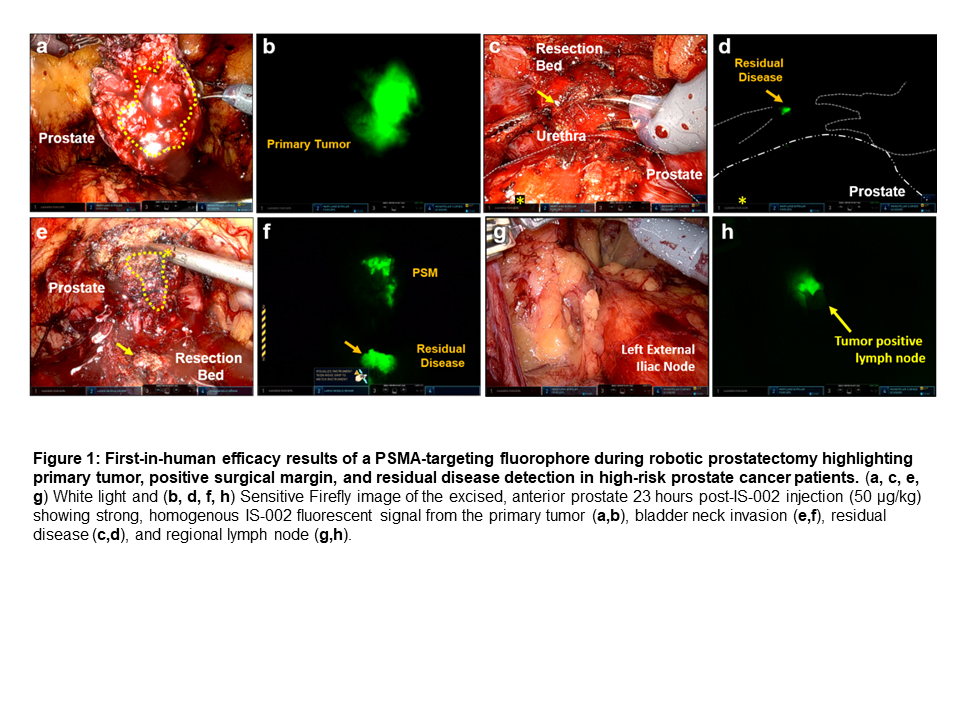Back
Poster, Podium & Video Sessions
Podium
PD54: Prostate Cancer: Localized: Surgical Therapy III
PD54-11: Results of the Phase 1 safety and efficacy Prostate Specific Membrane Antigen (PSMA) targeting fluorophore for image guided surgery in patients undergoing robotic prostatectomy
Monday, May 16, 2022
8:40 AM – 8:50 AM
Location: Room 245
Hao Nguyen*, San Francisco, CA, Alexander Antaris, Nynke Van den Berg, Sunnyvale, CA, Lingru Xue, Scott Greenberg, San Francisco, CA, Anna Muchnik, Alwin Klaassen, Sunnyvale, CA, Jeff Simko, Pamela Munster, San Francisco, CA, Sanjeev Dutta, Jonathan Sorger, Sunnyvale, CA, Peter Carroll, San Francisco, CA
.jpg)
Hao Gia Nguyen, MD, PHD
University of California, San Francisco
Podium Presenter(s)
Introduction:
Background: Recurrence rates after prostatectomy for high–risk prostate cancer remain unchanged, primarily due to failure to completely excise regional and/or locally extensive disease. This stems from the fundamental inability to visually differentiate cancer from healthy tissue. IS-002, a novel near-infrared PSMA-targeted fluorophore, is designed to enhance intraoperative cancer visualization during robotic prostatectomy. We hypothesize that IS-002 + fluorescence-guided surgery (FGS) may assist in cancer detection (locally and regionally), provide a more complete surgical excision, and thus improve oncological outcomes.
Objective: To evaluate IS-002 safety, pharmacokinetics, and efficacy in a phase 1, dose-escalation study (n=24) in high-risk prostate cancer (CAPRA 6-10) patients undergoing robotic prostatectomy using the da VinciTM Surgical System with Sensitive FireflyTM Fluorescence Imaging.
Methods: Study participants (n=24) received IS-002 intravenously 24 hr. prior to surgery, with six subjects per cohort (25, 50, 100, 150 µg/kg). IS-002’s pharmacokinetic profile, and safety (adverse events, labs, UA, ECG) was assessed over a 14-day period. Intraoperative/ex-vivo imaging correlation to pathology provided an estimate of efficacy.
Results: In 9/24 subjects (37.5%), IS-002 + FGS detected residual adenocarcinoma in the resection bed [including bladder neck (2/24), seminal vesicles (1/24), neurovascular bundle (4/24), levator ani (1/24), and Denonvilliers’ fascia (1/24) invasion] not visually identified under conventional white light imaging. IS-002 + FGS intraoperatively detected regional nodal metastases in 3/24 (12.5%) subjects. Surgeons reported excellent tumor discrimination over background (Figure 1). Ex vivo imaging confirmed IS-002 prostate tumor signal in 23/24 (95.8%) subjects. IS-002 was well-tolerated, with only Grade 1 AEs including green urine/feces (n=23) and bruising/rash (n=2).
Conclusions: IS-002 is safe and well tolerated, enabling enhanced intraoperative tumor detection. Based on the very encouraging results of this phase 1 study, a randomized phase 2 study is planned.
Source of Funding: Intuitive Surgical Inc. and Goldberg-Benioff Program in Translational Cancer Biology.

Background: Recurrence rates after prostatectomy for high–risk prostate cancer remain unchanged, primarily due to failure to completely excise regional and/or locally extensive disease. This stems from the fundamental inability to visually differentiate cancer from healthy tissue. IS-002, a novel near-infrared PSMA-targeted fluorophore, is designed to enhance intraoperative cancer visualization during robotic prostatectomy. We hypothesize that IS-002 + fluorescence-guided surgery (FGS) may assist in cancer detection (locally and regionally), provide a more complete surgical excision, and thus improve oncological outcomes.
Objective: To evaluate IS-002 safety, pharmacokinetics, and efficacy in a phase 1, dose-escalation study (n=24) in high-risk prostate cancer (CAPRA 6-10) patients undergoing robotic prostatectomy using the da VinciTM Surgical System with Sensitive FireflyTM Fluorescence Imaging.
Methods: Study participants (n=24) received IS-002 intravenously 24 hr. prior to surgery, with six subjects per cohort (25, 50, 100, 150 µg/kg). IS-002’s pharmacokinetic profile, and safety (adverse events, labs, UA, ECG) was assessed over a 14-day period. Intraoperative/ex-vivo imaging correlation to pathology provided an estimate of efficacy.
Results: In 9/24 subjects (37.5%), IS-002 + FGS detected residual adenocarcinoma in the resection bed [including bladder neck (2/24), seminal vesicles (1/24), neurovascular bundle (4/24), levator ani (1/24), and Denonvilliers’ fascia (1/24) invasion] not visually identified under conventional white light imaging. IS-002 + FGS intraoperatively detected regional nodal metastases in 3/24 (12.5%) subjects. Surgeons reported excellent tumor discrimination over background (Figure 1). Ex vivo imaging confirmed IS-002 prostate tumor signal in 23/24 (95.8%) subjects. IS-002 was well-tolerated, with only Grade 1 AEs including green urine/feces (n=23) and bruising/rash (n=2).
Conclusions: IS-002 is safe and well tolerated, enabling enhanced intraoperative tumor detection. Based on the very encouraging results of this phase 1 study, a randomized phase 2 study is planned.
Source of Funding: Intuitive Surgical Inc. and Goldberg-Benioff Program in Translational Cancer Biology.


.jpg)
.jpg)